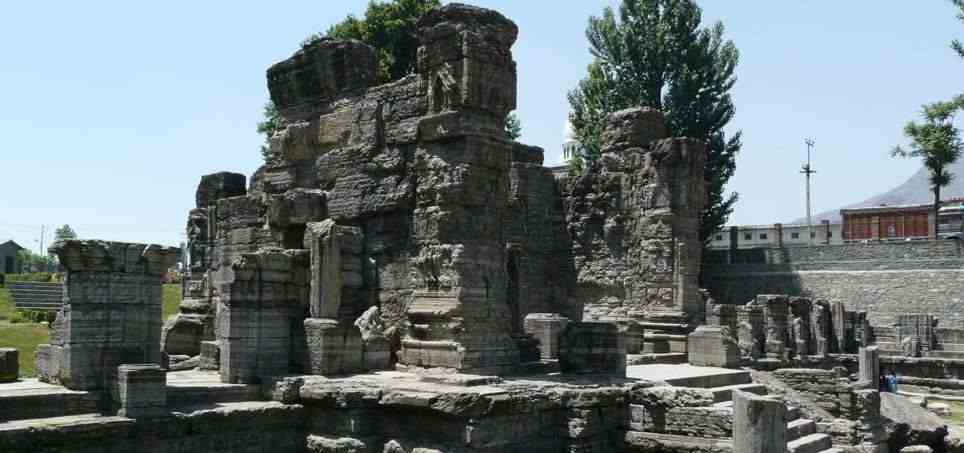Brief Introduction of Avantiswami Temple
 Brief Introduction of Avantiswami Temple
The Temple's a 28 kilometres from Srinagar, in the Anantnag district of Jammu and Kashmir, lies the small but significant historical town of Awantipora, which is situated on the banks of the Jhelum River. Between the years 855 and 883 AD, monarch Avantivarman of the Utpala dynasty constructed the town. So the location was given the name Awantipora. At Avantipura, he built two beautiful temples: Avantiswami, which is devoted to Lord Vishnu, and Avantisvara, which is devoted to Lord Shiva. Avantisavara temple was erected after gaining control, but Avantiswami temple was established before he succeeded to the kingdom. The temple saw invasion and ruin during the Middle Ages. It was eventually reduced to ruins. Early in the 20th century, an excavation turned up the ruins of the sub-shrines as well as the whole quadrangle of the temple, which extended all the way to the courtyard floor. It also showed how deep the central shrine's basement went. 121 coins that belonged to Afghan kings of the Durrani and Shah Miri dynasties were found thanks to the excavation.
Avantiswami Temple, Awantipora, Jammu & Kashmir
Brief Introduction of Avantiswami Temple
The Temple's a 28 kilometres from Srinagar, in the Anantnag district of Jammu and Kashmir, lies the small but significant historical town of Awantipora, which is situated on the banks of the Jhelum River. Between the years 855 and 883 AD, monarch Avantivarman of the Utpala dynasty constructed the town. So the location was given the name Awantipora. At Avantipura, he built two beautiful temples: Avantiswami, which is devoted to Lord Vishnu, and Avantisvara, which is devoted to Lord Shiva. Avantisavara temple was erected after gaining control, but Avantiswami temple was established before he succeeded to the kingdom. The temple saw invasion and ruin during the Middle Ages. It was eventually reduced to ruins. Early in the 20th century, an excavation turned up the ruins of the sub-shrines as well as the whole quadrangle of the temple, which extended all the way to the courtyard floor. It also showed how deep the central shrine's basement went. 121 coins that belonged to Afghan kings of the Durrani and Shah Miri dynasties were found thanks to the excavation.
Avantiswami Temple, Awantipora, Jammu & Kashmir
Lidder Avantiswami Temple
 The Temple's a 28 kilometres from Srinagar, in the Anantnag district of Jammu and Kashmir, lies the small but significant historical town of Awantipora, which is situated on the banks of the Jhelum River. Between the years 855 and 883 AD, monarch Avantivarman of the Utpala dynasty constructed the town. So the location was given the name Awantipora. At Avantipura, he built two beautiful temples: Avantiswami, which is devoted to Lord Vishnu, and Avantisvara, which is devoted to Lord Shiva. Avantisavara temple was erected after gaining control, but Avantiswami temple was established before he succeeded to the kingdom. The temple saw invasion and ruin during the Middle Ages. It was eventually reduced to ruins. Early in the 20th century, an excavation turned up the ruins of the sub-shrines as well as the whole quadrangle of the temple, which extended all the way to the courtyard floor. It also showed how deep the central shrine's basement went. 121 coins that belonged to Afghan kings of the Durrani and Shah Miri dynasties were found thanks to the excavation.
The Temple's a 28 kilometres from Srinagar, in the Anantnag district of Jammu and Kashmir, lies the small but significant historical town of Awantipora, which is situated on the banks of the Jhelum River. Between the years 855 and 883 AD, monarch Avantivarman of the Utpala dynasty constructed the town. So the location was given the name Awantipora. At Avantipura, he built two beautiful temples: Avantiswami, which is devoted to Lord Vishnu, and Avantisvara, which is devoted to Lord Shiva. Avantisavara temple was erected after gaining control, but Avantiswami temple was established before he succeeded to the kingdom. The temple saw invasion and ruin during the Middle Ages. It was eventually reduced to ruins. Early in the 20th century, an excavation turned up the ruins of the sub-shrines as well as the whole quadrangle of the temple, which extended all the way to the courtyard floor. It also showed how deep the central shrine's basement went. 121 coins that belonged to Afghan kings of the Durrani and Shah Miri dynasties were found thanks to the excavation.